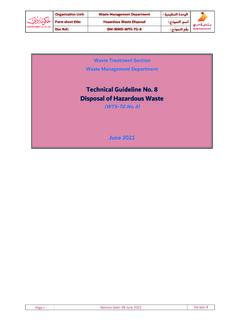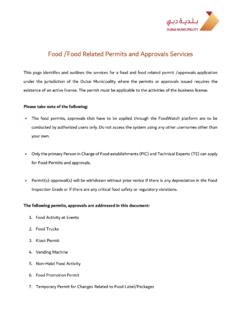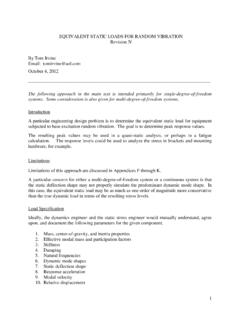Transcription of Dubai Wind Code - Dubai Municipality
1 Dubai WIND CODE. Draft Copy Dubai Municipality 2013. CONTENTS. 1. GENERAL ..3. NOTATION ..3. COVERAGE AND IMPLEMENTATION ..4. 2. GENERAL GUIDELINES FOR WIND LOADS ..4. 3. VELOCITY OF WIND ..5. AVERAGE WIND VELOCITY ..5. Structure of wind in Dubai ..5. Basic wind velocity ..6. Surface friction coefficient ..9. Ct topography coefficient .9. Effects of neighbouring structures on average wind velocity ..10. FLUCTUATING WIND VELOCITY (TURBULANCE) .11. Turbulance intensity ..11. Turbulance length ..11. Power spectral density of turbulance 12. MAXIMUM WIND VELOCITY.
2 12. 4. WIND PRESSURE ..13. MAXIMUM PRESSURE AT A POINT ..13. MAXIMUM WIND load ON A SURFACE 14. PRESSURE COEFFICIENTS FOR THE VERTICAL WALLS OF RECTANGULAR. BUILDINGS .15. PRESSURE COEFFICIENTS FOR ROOFS AND OTHER STRUCTURES .16. 5. WIND LOADS ON BUILDINGS 16. WIND LOADS ON BUILDINGS WITH RECTANGULAR CROSS-SECTIONS 16. WIND LOADS ON BUILDINGS WITH CIRCULAR CROSS-SECTIONS ..19. ESTIMATION OF FREQUENCIES AND DAMPING OF BUILDINGS ..22. 6. CALCULATION OF WIND-INDUCED MAXIMUM ACCELERATIONS .22. 7. ACROSS-WIND RESPONSE OF BUILDINGS .22. 8. WAKE BUFFETING 25. 9. WIND TUNNEL TESTS.
3 25. REFERENCES .26. 2. 1. GENERAL. NOTATION. A = Surface area b = Width of a structure in the across-wind direction B2 = Correlation factor that accounts for the lack of correlation of wind pressures Cd = Dynamic amplification factor Ce(z) = Height-dependent surface friction coefficients Cp = Surface pressure coefficient Cp,1 = Surface pressure coefficient for m2 area Cp,10 = Surface pressure coefficient for m2 area Cq(z) = Height-dependent wind pressure coefficient Cs = load correlation coefficient Ct = Topography coefficient D = Diameter of circular cross-section of a building d = Width of the structure in the along-wind direction F = Total wind loads on a building f = Frequency in Hz fL(z,f) = Nondimensional normalized frequency fo = First natural frequency of a building in Hz.
4 H = Height of the building. h0 = Average height of surrounding buildings hy = Ficticous increase in ground level to account for surrounding structures Iw(z) = Height-dependent turbulance intensity L(z) = Height-dependent turbulance length Q(z) = Total wind load in a sbuilding at height z qb = Basic wind pressure qp(z) = Wind pressure for unit area at height z R2 = Resonance factor that accounts for dynamic amplification of response Rb(Kb) = Aerodynamic admittance function in horizontal direction Rh(Kh) = Aerodynamic admittance function in vertical direction SL(z,f)
5 = Power spectral density function of turbulance St = Strouhal number Vb = Basic wind speed V(z,t) = Total wind speed _V(z,t)_max= Maximum total wind sped at height z Vcr = Critical wind speed for vortex shedding Vm (z) = Height-dependent average wind velocity w(z,t) ) = Dynamic component of wind velocity turbulance. wmax = Maximum turbulance velocity zo = Surface friction coefficient zmin = Minimum height in which surface friction is constant zr = Reference height G = Logarithmic decrement corresponding to the first vibration mode [o = Damping coefficient corresponding to the first vibration mode = Mass density of air ( = N/m3).]
6 Vw = Standard deviation of turbulance 3. COVERAGE AND IMPLEMENTATION. This document gives the minimum loads that will be considered when designing structures for wind, including the main structural system, external facade elements, and other components that are exposed to wind. The development of a structural design code is a long and continuous process that requires consensus from all parties involved. This code is the first step for a comprehensive wind design code for Dubai . 2. GENERAL GUIDELINES FOR WIND LOADS. Wind loads are composed of static and dynamic components.
7 The loads given in this code are the equivalent static wind loads, under which the static deformations of the structure are equal to the sum of static and dynamic deformations induced by wind. The total wind load on the main load carrying system of the structure is equal to the vectoral sum of the wind loads acting on all surfaces of the structure. The wind loads on the main structural system, external facade elements, and other non- structural components that are exposed to wind cannot be less than kN/m2. 3. VELOCITY OF WIND. Wind velocity is defined by the following equation: V ( z, t ) Vm ( z) w( z, t ) ( ).
8 Where V ( z, t ) : Total wind velocity at height z at time t. Vm ( z) : Mean component ( , the average) of wind velocity at height z. w( z, t ) : Dynamic component of wind velocity ( , turbulance) at height z at time t. AVERAGE WIND VELOCITY. 4. At a given location, the average wind velocity, Vm(z), at height z is calculated from the following equation : Vm (z) Ce(z) Ct Vb ( ). where Vm ( z) : Average wind velocity at height z. Vb : Basic wind speed. Ce ( z) : Effect of surface roughness at height z. Ct : Effect of surface topography. Structure of wind in Dubai The structure of wind in Dubai is controlled by three different wind phenomena: synoptic winds, Shamal winds, and thunderstorms.
9 The vertical profile of synoptic wind velocities can be modelled by using the standard logarithmic profile model, where the velocity increases monotonically with height and reaches its maximum at the top of the building. Shamal winds, which are the result of desert environment and climate in the region, reach their peak velocity around 200 m. The velocity becomes smaller as the altitude gets higher. The thunderstorms typically have their peak velocities around the height of 50 m. The recorded synoptic wind speeds at 10m height are less than those recorded at the same height during thunderstorm events.
10 Although there are several important studies done on the structure of wind in Dubai , further research is needed to quantify the profiles of Shamal winds and thunderstorms, so that they can be incorporated in design codes. Studies have shown that for extreme cases the synoptic winds still control the design. Also, the comparison of velocity profiles in several codes does not suggest any major flaw in extending the log law beyond 200m , which is the limit in Eurocode, in light of many other more pressing uncertainties that surface in the quantification of wind velocity profiles.









